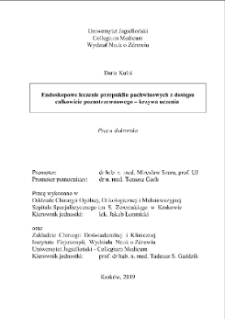Obiekt
Tytuł: Totally extraperitoneal hernia repair : learning curve
Abstrakt:
Introduction: The TEP hernia repair is being used for many years, but its learning curve is still unknown.Aim: The aim of the study was to evaluate TEP learning curve and to assess cut-off point, where learning curve stabilizes.Material and methods: Retrospective analysis of prospectively collected data of patients who were submitted to TEP in the Zeromski Hospital. We included patients that underwent TEP in years 2008-2018. Patients meeting the study inclusion et exclusion criteria were used for statistical analysis. The primary endpoint was determining the stabilization point of the TEP learning curve using operative time and perioperative outcomes.Results: In the study group 73 of 104 patients met the inclusive criteria. The control group was 31 of 101 patients. Multiple comparisons of median ranges revealed, that after 16th TEP the operative time did not differ consecutive groups of procedures. Learning curve stabilization point in terms of operative time is 16th procedure. Intraoperative complications occurred only in groups BII and K, that is why we cannot use it to determine learning curve stabilization point. LOS differed significantly groups (p<0.001). In terms of cut-off point, after group BIII has been operated on, the LOS did not differ groups. Conclusions: Cut-off point of TEP using operative time is 16th procedure. In our unit, the LOS stabilized after group G3 ha ; s been operated on.
Miejsce wydania:
Stopień studiów:
Dyscyplina:
Instytucja nadająca tytuł:
Promotor:
Szura, Mirosław ; Gach, Tomasz
Data wydania:
Identyfikator:
Sygnatura:
Język:
Prawa dostępu:
Kolekcje, do których przypisany jest obiekt:
Data ostatniej modyfikacji:
13 mar 2023
Data dodania obiektu:
7 kwi 2020
Liczba wyświetleń treści obiektu:
6
Liczba wyświetleń treści obiektu w formacie PDF
0
Wszystkie dostępne wersje tego obiektu:
http://dl.cm-uj.krakow.pl:8080/publication/4309
Wyświetl opis w formacie RDF:
Wyświetl opis w formacie OAI-PMH:
| Nazwa wydania | Data |
|---|---|
| ZB-131181 | 13 mar 2023 |
Obiekty
Podobne
Kuliś, Daria
Łomnicki, Jakub
Biel-Wiendlocha, Agnieszka
Piątkowski, Maciej
Cieśla-Dul, Mariola
Fronczek, Jakub
Warmus, Janusz
Pitak, Maciej

